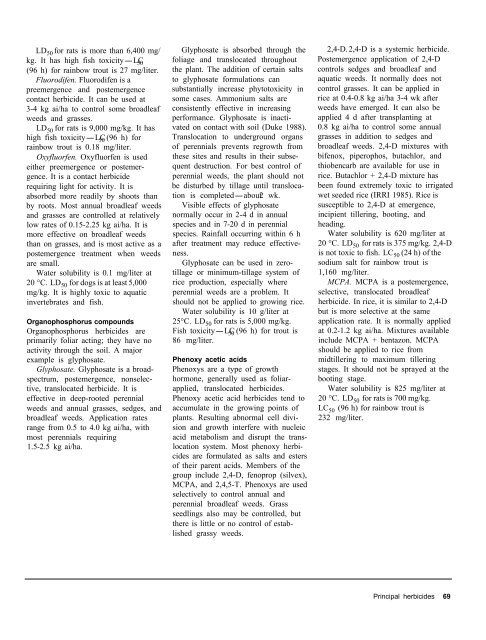A handbbok on Weed Control in Rice.pdf
A handbbok on Weed Control in Rice.pdf
A handbbok on Weed Control in Rice.pdf
You also want an ePaper? Increase the reach of your titles
YUMPU automatically turns print PDFs into web optimized ePapers that Google loves.
LD 50 for rats is more than 6,400 mg/<br />
kg. It has high fish toxicity-LC 50<br />
(96 h) for ra<strong>in</strong>bow trout is 27 mg/liter.<br />
Glyphosate is absorbed through the<br />
foliage and translocated throughout<br />
the plant. The additi<strong>on</strong> of certa<strong>in</strong> salts<br />
Fluorodifen. Fluorodifen is a<br />
to glyphosate formulati<strong>on</strong>s can<br />
preemergence and postemergence substantially <strong>in</strong>crease phytotoxicity <strong>in</strong><br />
c<strong>on</strong>tact herbicide. It can be used at some cases. Amm<strong>on</strong>ium salts are<br />
3-4 kg ai/ha to c<strong>on</strong>trol some broadleaf c<strong>on</strong>sistently effective <strong>in</strong> <strong>in</strong>creas<strong>in</strong>g<br />
weeds and grasses.<br />
performance. Glyphosate is <strong>in</strong>acti-<br />
LD 50 for rats is 9,000 mg/kg. It has<br />
high fish toxicity-LC 50 (96 h) for<br />
ra<strong>in</strong>bow trout is 0.18 mg/liter.<br />
vated <strong>on</strong> c<strong>on</strong>tact with soil (Duke 1988).<br />
Translocati<strong>on</strong> to underground organs<br />
of perennials prevents regrowth from<br />
Oxyfluorfen. Oxyfluorfen is used these sites and results <strong>in</strong> their subseeither<br />
preemergence or postemer- quent destructi<strong>on</strong>. For best c<strong>on</strong>trol of<br />
gence. It is a c<strong>on</strong>tact herbicide<br />
perennial weeds, the plant should not<br />
requir<strong>in</strong>g light for activity. It is be disturbed by tillage until translocaabsorbed<br />
more readily by shoots than ti<strong>on</strong> is completed-about 2 wk.<br />
by roots. Most annual broadleaf weeds Visible effects of glyphosate<br />
and grasses are c<strong>on</strong>trolled at relatively normally occur <strong>in</strong> 2-4 d <strong>in</strong> annual<br />
low rates of 0.15-2.25 kg ai/ha. It is species and <strong>in</strong> 7-20 d <strong>in</strong> perennial<br />
more effective <strong>on</strong> broadleaf weeds species. Ra<strong>in</strong>fall occurr<strong>in</strong>g with<strong>in</strong> 6 h<br />
than <strong>on</strong> grasses, and is most active as a after treatment may reduce effectivepostemergence<br />
treatment when weeds ness.<br />
are small.<br />
Glyphosate can be used <strong>in</strong> zero-<br />
Water solubility is 0.1 mg/liter at tillage or m<strong>in</strong>imum-tillage system of<br />
20 °C. LD 50 for dogs is at least 5,000 rice producti<strong>on</strong>, especially where<br />
mg/kg. It is highly toxic to aquatic perennial weeds are a problem. It<br />
<strong>in</strong>vertebrates and fish.<br />
should not be applied to grow<strong>in</strong>g rice.<br />
Water solubility is 10 g/liter at<br />
25°C. LD 50 for rats is 5,000 mg/kg.<br />
Fish toxicity-LC 50 (96 h) for trout is<br />
86 mg/liter.<br />
Organophosphorus compounds<br />
Organophosphorus herbicides are<br />
primarily foliar act<strong>in</strong>g; they have no<br />
activity through the soil. A major<br />
example is glyphosate.<br />
Glyphosate. Glyphosate is a broad-<br />
spectrum, postemergence, n<strong>on</strong>selec-<br />
tive, translocated herbicide. It is<br />
effective <strong>in</strong> deep-rooted perennial<br />
weeds and annual grasses, sedges, and<br />
broadleaf weeds. Applicati<strong>on</strong> rates<br />
range from 0.5 to 4.0 kg ai/ha, with<br />
most perennials requir<strong>in</strong>g<br />
1.5-2.5 kg ai/ha.<br />
Phenoxy acetic acids<br />
Phenoxys are a type of growth<br />
horm<strong>on</strong>e, generally used as foliar-<br />
applied, translocated herbicides.<br />
Phenoxy acetic acid herbicides tend to<br />
accumulate <strong>in</strong> the grow<strong>in</strong>g po<strong>in</strong>ts of<br />
plants. Result<strong>in</strong>g abnormal cell divi-<br />
si<strong>on</strong> and growth <strong>in</strong>terfere with nucleic<br />
acid metabolism and disrupt the trans-<br />
locati<strong>on</strong> system. Most phenoxy herbi-<br />
cides are formulated as salts and esters<br />
of their parent acids. Members of the<br />
group <strong>in</strong>clude 2,4-D, fenoprop (silvex),<br />
MCPA, and 2,4,5-T. Phenoxys are used<br />
selectively to c<strong>on</strong>trol annual and<br />
perennial broadleaf weeds. Grass<br />
seedl<strong>in</strong>gs also may be c<strong>on</strong>trolled, but<br />
there is little or no c<strong>on</strong>trol of estab-<br />
lished grassy weeds.<br />
2,4-D. 2,4-D is a systemic herbicide.<br />
Postemergence applicati<strong>on</strong> of 2,4-D<br />
c<strong>on</strong>trols sedges and broadleaf and<br />
aquatic weeds. It normally does not<br />
c<strong>on</strong>trol grasses. It can be applied <strong>in</strong><br />
rice at 0.4-0.8 kg ai/ha 3-4 wk after<br />
weeds have emerged. It can also be<br />
applied 4 d after transplant<strong>in</strong>g at<br />
0.8 kg ai/ha to c<strong>on</strong>trol some annual<br />
grasses <strong>in</strong> additi<strong>on</strong> to sedges and<br />
broadleaf weeds. 2,4-D mixtures with<br />
bifenox, piperophos, butachlor, and<br />
thiobencarb are available for use <strong>in</strong><br />
rice. Butachlor + 2,4-D mixture has<br />
been found extremely toxic to irrigated<br />
wet seeded rice (IRRI 1985). <strong>Rice</strong> is<br />
susceptible to 2,4-D at emergence,<br />
<strong>in</strong>cipient tiller<strong>in</strong>g, boot<strong>in</strong>g, and<br />
head<strong>in</strong>g.<br />
Water solubility is 620 mg/liter at<br />
20 °C. LD 50 for rats is 375 mg/kg. 2,4-D<br />
is not toxic to fish. LC 50 (24 h) of the<br />
sodium salt for ra<strong>in</strong>bow trout is<br />
1,160 mg/liter.<br />
MCPA. MCPA is a postemergence,<br />
selective, translocated broadleaf<br />
herbicide. In rice, it is similar to 2,4-D<br />
but is more selective at the same<br />
applicati<strong>on</strong> rate. It is normally applied<br />
at 0.2-1.2 kg ai/ha. Mixtures available<br />
<strong>in</strong>clude MCPA + bentaz<strong>on</strong>. MCPA<br />
should be applied to rice from<br />
midtiller<strong>in</strong>g to maximum tiller<strong>in</strong>g<br />
stages. It should not be sprayed at the<br />
boot<strong>in</strong>g stage.<br />
Water solubility is 825 mg/liter at<br />
20 °C. LD 50 for rats is 700 mg/kg.<br />
LC 50 (96 h) for ra<strong>in</strong>bow trout is<br />
232 mg/liter.<br />
Pr<strong>in</strong>cipal herbicides 69











